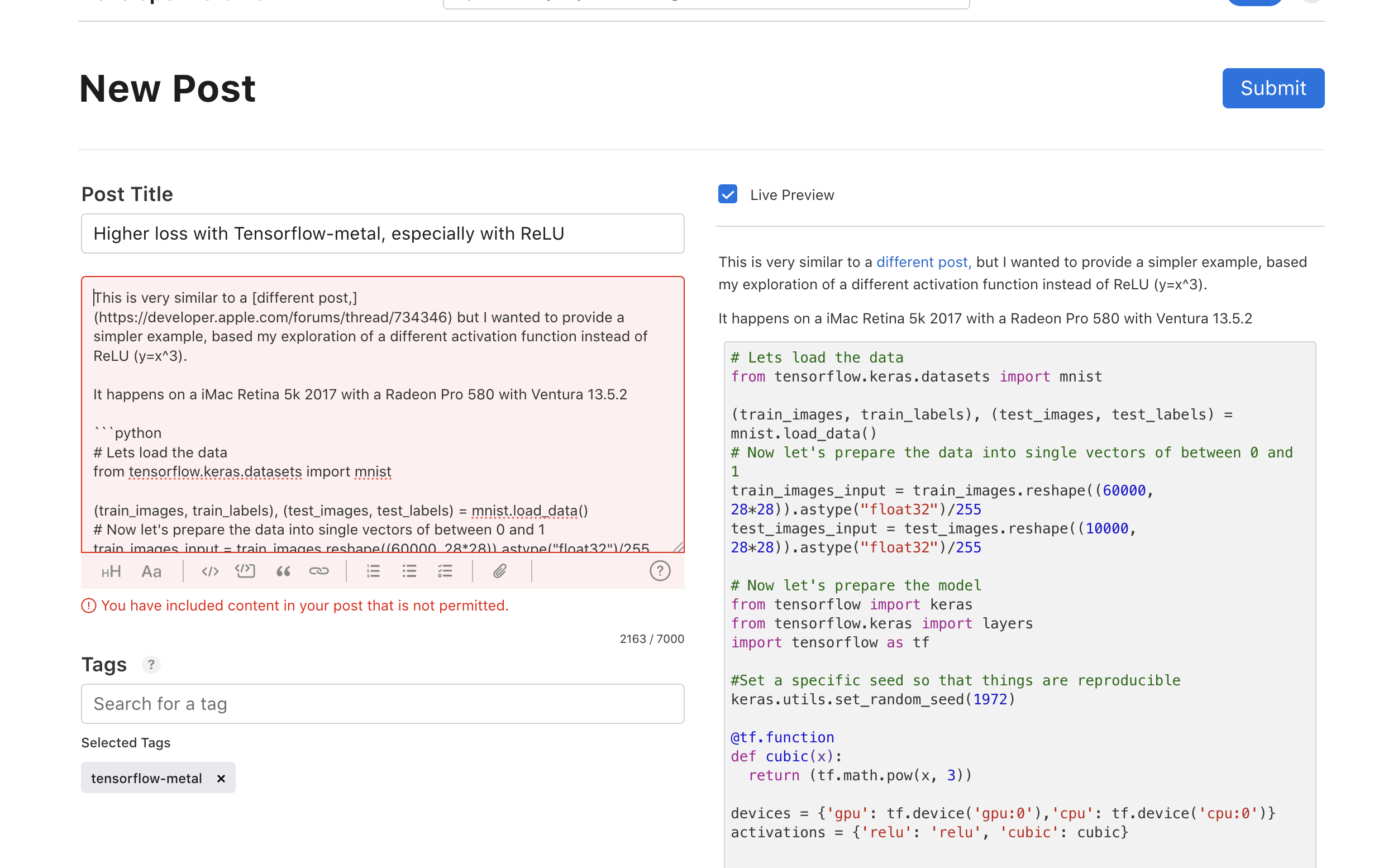Higher loss with Tensorflow-metal, especially with ReLU
tensorflow-metal might have an issue
A few days ago, while working on my post about how y=x3 might be a good activation function, I discovered an issue with tensorflow-metal, the python package to use your GPU in Tensorflow on a Mac.
I’ve tried to find the code for tensorflow-metal, but it seems the code is only a wrapper on a library.
I also tried to create a post on Apple’s developer forums, but it doesn’t allow me
 “You have included content in your post that is not permitted”. Which content?
“You have included content in your post that is not permitted”. Which content?
I ended up writing a short message on a similar (but not exactly the same) issue
I noticed that a set of random values gets more decimal figures in GPU than in CPU.
So with this code
import tensorflow as tf # TensorFlow registers PluggableDevices here.
with tf.device("/GPU:0"):
tf.random.set_seed(1972)
agpu = tf.random.normal(shape=[5], dtype=tf.float32)
print("GPU - Random",agpu)
with tf.device("/CPU:0"):
tf.random.set_seed(1972)
acpu = tf.random.normal(shape=[5], dtype=tf.float32)
print("CPU - Random",acpu)
print("equal ", tf.equal(agpu, acpu))
I get
GPU - Random tf.Tensor([-0.88528407 0.33968228 -2.0363083 1.1200726 -1.0055897 ], shape=(5,), dtype=float32)
CPU - Random tf.Tensor([-0.8852841 0.3396823 -2.036308 1.1200724 -1.00559 ], shape=(5,), dtype=float32)
equal tf.Tensor([False False False False False], shape=(5,), dtype=bool)
But if I do the same in colab (Google) I get
GPU - Random tf.Tensor([-0.8852841 0.3396823 -2.036308 1.1200724 -1.00559 ], shape=(5,), dtype=float32)
CPU - Random tf.Tensor([-0.8852841 0.3396823 -2.036308 1.1200724 -1.00559 ], shape=(5,), dtype=float32)
equal tf.Tensor([ True True True True True], shape=(5,), dtype=bool)
But the proper example appears checking with other loss functions
# Lets load the data
from tensorflow.keras.datasets import mnist
(train_images, train_labels), (test_images, test_labels) = mnist.load_data()
# Now let's prepare the data into single vectors of between 0 and 1
train_images_input = train_images.reshape((60000, 28*28)).astype("float32")/255
test_images_input = test_images.reshape((10000, 28*28)).astype("float32")/255
# Now let's prepare the model
from tensorflow import keras
from tensorflow.keras import layers
import tensorflow as tf
#Set a specific seed so that things are reproducible
keras.utils.set_random_seed(1972)
@tf.function
def cubic(x):
return (tf.math.pow(x, 3))
devices = {'gpu': tf.device('gpu:0'),'cpu': tf.device('cpu:0')}
activations = {'relu': 'relu', 'cubic': cubic}
def get_model(activation_function):
model = keras.Sequential([
layers.Dense(100, activation = activation_function),
layers.Dense(10, activation = 'softmax'),
])
model.compile(optimizer = 'rmsprop',
loss = 'sparse_categorical_crossentropy',
metrics = ['accuracy'])
return model
results = []
for name_activation, activation in activations.items():
for name_device, device in devices.items():
with device:
model = get_model(activation)
model.fit(train_images_input, train_labels, epochs=5, batch_size=128)
test_error = model.evaluate(test_images_input, test_labels)
results.append((name_device, name_activation, test_error))
results
which provide the following results
[('gpu', 'relu', [0.2844949960708618, 0.9228000044822693]),
('cpu', 'relu', [0.09160187095403671, 0.9718999862670898]),
('gpu', 'cubic', [0.13812969624996185, 0.9686999917030334]),
('cpu', 'cubic', [0.14605630934238434, 0.9715999960899353])]
As you can see, the code trains a model with a combination of GPU and CPU on one side, and ReLU or cubic as an activation function, on the other side.
Using ReLU, the loss is significantly higher (and the accuracy lower) when using GPU compared to using CPU.
Using cubic, there are some differences on the results, but not so dramatic.
It seems the issue might be with precision on metal-based GPUs, but it is surprising ReLU is more susceptible.